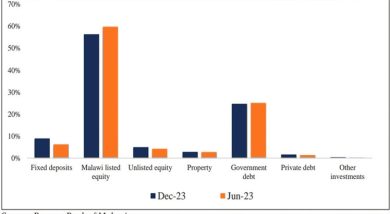Players fear for gas sector
Players in the gas-sub sector have expressed fear over potential reduction in demand for gas following authorities’ decision to hike the product by 12.11 percent.
On Saturday, Malawi Energy Regulatory Authority (Mera) increased the price of liquid petroleum gas (LPG) by 12.11 percent due to increased global prices and the depreciation of the South African rand against the local unit.
The increase comes at a time when the consumption of LPG, at 150 grammes per capita, is the lowest in the region, and the country is trying to diversify energy sources.
Now costing K2 291.82 per kilogramme (kg), consumers will have to cough an extra K265 per kg of LPG bought.

In April, Mera reduced the maximum retail LPG prices by 3.57 percent from K2 119.87 to K2 044.22.
LPG—known in some countries as propane, butane, bottled gas or cooking gas—is a clean-burning and efficient cooking fuel used by almost three billion people. It has long been an inspirational fuel choice for many urban and rural poor.
In an interview on Monday, Consumers Association of Malawi (Cama) executive director John Kapito said the price hike will negatively affect consumers and efforts to diversify energy sources.
“People were slowly adopting the energy mix and diversifying sources but the adjustments means that it will become a bit expensive to use LPG in the households although we understand that the product does not have enough resources in its price stabilisation fund to cushion consumers because of low uptake,” he said.
Lilongwe-based LPG distributor 265 Energy Limited chief executive officer Mfundo Mbvundula observed yesterday that the price hike will affect the firm’s campaign of encouraging consumers to switch to gas.
“As we are currently on a #Switch2Gas campaign, we believe this upward adjustment will significantly affect our efforts to have people switch from charcoal or electricity to gas.
“Our gas price is particularly high for the region as it is. This kind of pricing makes it extremely difficult to convince potential users to switch to gas as it becomes too expensive for the average household.
“Government must work to bring the price of LPG down if we are to succeed in reducing the charcoal consumption in the country,” he said.
Another player observed that the adjustments will only make the commodity more affordable to middle-and high income earners, leaving out low-income earners banking on forests, thereby depleting the environment.
“If only government could subsidise gas cylinders and remove some of the taxes in the gas price build up, the fight against environmental degradation will be continuing with no solutions in sight.”
Energy expert Grain Malunga observed that as long as the country does not subsidise the price of LPG, penetration into the districts and rural areas will be a far-fetched dream.
Use of solid fuels for cooking can also cause forest loss and degradation where concentrated use of wood fuels is prevalent, typically in and around urban centres.
In Malawi, the World Bank reports that land degradation alone costs the economy 6.8 percent of the gross domestic product (GDP) annually.
Mera is, however, banking on new guidelines for LPG to increase uptake which, at 150 grammes per capita, is the lowest in the region.
Mera director of liquid fuels and gas Alinafe Mkavea is on record as having said that the energy regulator is banking on new guidelines for LPG to increase uptake of gas, address issues of prices of gas cylinders as well as levies.
“A gas cylinder with one stove now costs an average of K60 000, which in itself is prohibitive to consumers. We are also engaging government so that it can remove some of the levies on gas to make it cheaper and easily accessible,” she said.
The 2018 National Energy Policy confirms of the several barriers to increased use which mainly are due to its high cost.
The policy emphasises on the need to look at ways of doing away with barriers to lower pricing and increased uptake of LPG and to identify potential partnerships to promote greater market penetration.
Meanwhile, Mera has maintained fuel pump prices at K868, K874 and K710.50 for petro, diesel and paraffin, respectively. Jet A prices have also been maintained at K705.24 and K655.51 at Kamuzu and Chileka international airports, respectively.





